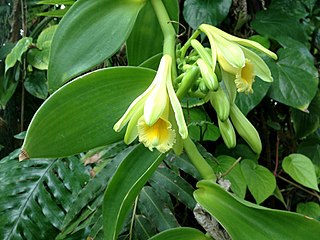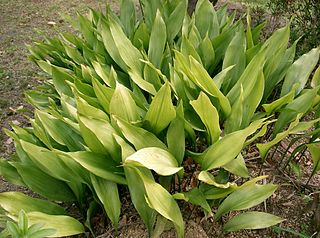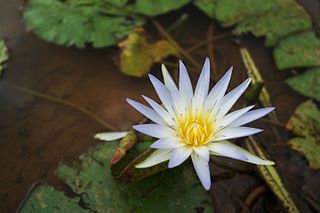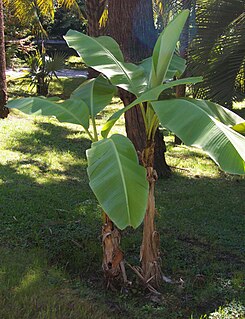
Vanilla is a spice derived from orchids of the genus Vanilla, primarily obtained from pods of the Mexican species, flat-leaved vanilla (V. planifolia). The word vanilla, derived from vainilla, the diminutive of the Spanish word vaina, is translated simply as "little pod". Pre-Columbian Mesoamerican people cultivated the vine of the vanilla orchid, called tlīlxochitl by the Aztecs.

Aspidistra is a genus of flowering plants in the family Asparagaceae, subfamily Nolinoideae, native to eastern and southeastern Asia, particularly China and Vietnam. They grow in shade under trees and shrubs. Their leaves arise more or less directly from ground level, where their flowers also appear. The number of species known has increased considerably from the 1980s onwards, with around 100 accepted as of July 2013. Aspidistra elatior is common worldwide as a foliage house plant that is very tolerant of neglect. It and other species can also be grown in shade outside, where they are generally hardy to −5 °C (23 °F).

Bauhinia is a large genus of flowering plants in the subfamily Cercidoideae and tribe Bauhinieae, in the large flowering plant family Fabaceae, with a pantropical distribution. The genus was named after the Bauhin brothers Gaspard and Johann, Swiss-French botanists.

Cymbidium, commonly known as boat orchids, is a genus of evergreen flowering plants in the orchid family Orchidaceae. Orchids in this genus are epiphytic, lithophytic, terrestrial or rarely leafless saprophytic herbs usually with pseudobulbs. There are usually between three and twelve leaves arranged in two ranks on each pseudobulb or shoot and lasting for several years. From one to a large number of flowers are arranged on an unbranched flowering stem arising from the base of the pseudobulb. The sepals and petals are all free from and similar to each other. The labellum is significantly different from the other petals and the sepals and has three lobes. There are about fifty-five species and sixteen further natural hybrids occurring in the wild from tropical and subtropical Asia to Australia. Cymbidiums are well known in horticulture and many cultivars have been developed.

Curcuma is a genus of about 100 accepted species in the family Zingiberaceae that contains such species as turmeric and Siam tulip. They are native to Southeast Asia, southern China, the Indian Subcontinent, New Guinea and northern Australia. Some species are reportedly naturalized in other warm parts of the world such as tropical Africa, Central America, Florida, and various islands of the Pacific, Indian and Atlantic Oceans. Generally, most curcuma grows well in loose and sandy soil in shaded areas.

Nymphaea nouchali var. caerulea, or previously Nymphaea caerulea, known primarily as blue lotus, but also blue water lily, and sacred blue lily, is a water lily in the genus Nymphaea, as a variety of Nymphaea nouchali. Like other species in the genus, the plant contains the psychoactive alkaloid aporphine. It was known to the Ancient Egyptian civilization.

Scutellaria baicalensis, with the common name Baikal skullcap or Chinese skullcap, is a species of flowering plant in the family Lamiaceae.

The masked palm civet, also called the gem-faced civet, is a palm civet species native to the Indian subcontinent and Southeast Asia. It has been listed as least concern on the IUCN Red List since 2008 as it occurs in many protected areas, is tolerant to some degree of habitat modification, and widely distributed with presumed large populations that are unlikely to be declining.

Andrographis paniculata, commonly known as creat or green chiretta, is an annual herbaceous plant in the family Acanthaceae, native to India and Sri Lanka. Other common names for the plant include King of Bitter.

Choerospondias axillaris, known in English as the Nepali hog plum, is a tree in the family Anacardiaceae. It is a common fruit in Nepal also called lapsi. It is native to Nepal. Its fruit is about 3 centimeters long and has a soft whitish sour flesh and green to yellow skin. The fruit is made into pickles, fruit tarts, and sour, spicy candy in Nepal. The tree has long been cultivated in rural Nepal for its fruit. The fruit is nutritious and has a price comparable to the mandarin orange on the Nepalese market.

Vanilla somae is a species of Vanilla native to the forests of Taiwan, northern Vietnam and Laos. The scientific names Vanilla albida and Vanilla griffithii are sometimes misapplied to this species, but they are actually three different species.

Rene Liu Ruo-ying is a Taiwanese singer-songwriter, actress, director and writer. In the Sinophone world, Liu is widely known by her affectionate nickname "Milk Tea". Her music often focuses on love stories and has built an image around herself as a single woman. She is known for her mature, professional, urbane, single woman persona.

Musa basjoo, known variously as Japanese banana, Japanese fibre banana or hardy banana, is a species belonging to the genus Musa. It was previously thought to have originated in the Ryukyu islands of southern Japan, from where it was first described in cultivation, but is now known to have originated in subtropical southern China, where it is also widely cultivated, with wild populations found in Sichuan province.

Estrogen-related receptor beta (ERR-β), also known as NR3B2, is a nuclear receptor that in humans is encoded by the ESRRB gene.

Dendrolirium is a genus of orchids.

As Baicalin is a flavone glycoside, it is a flavonoid. It is the glucuronide of baicalein.

Dendrolirium lasiopetalum, synonym Eria lasiopetala, is a species of orchid. It is native to a region from Bangladesh east to Hong Kong, south through much of Southeast Asia to Java.

T.H. Tse is a Hong Kong academic who is a professor and researcher in program testing and debugging. He is ranked in the top four of most prolific authors in test oracles and in metamorphic testing. The application areas of his research include object-oriented software, services computing, pervasive computing, concurrent systems, imaging software, and numerical programs. In addition, he creates graphic designs for non-government organizations.
Guan Yi is a Chinese virologist. In 2014, he was ranked as 11th in the world by Thomson Reuters among global researchers in the field of microbiology. He obtained his PhD in microbiology at the University of Hong Kong and is now a professor of microbiology at his alma mater. His research on the viral respiratory disease SARS helped the Chinese government avert the 2004 outbreak of this disease. He is the current Director of the State Key Laboratory for Emerging Infectious Diseases University of Hong Kong. In early 2017, Guan warned that the H7N9 influenza virus "poses the greatest threat to humanity than any other in the past 100 years."
Anarchism in Hong Kong emerged as part of the Chinese anarchist movement, when many anarchists sought refuge from the Qing Empire in the island. It grew alongside the Chinese revolutionary movement, before the island again became a safe haven for anarchists, following the Communist victory in the Chinese Civil War. Since then anarchists have formed a part of the Hong Kong opposition movement, first to British colonial rule and then to the rising authoritarianism of the Government of Hong Kong.
















